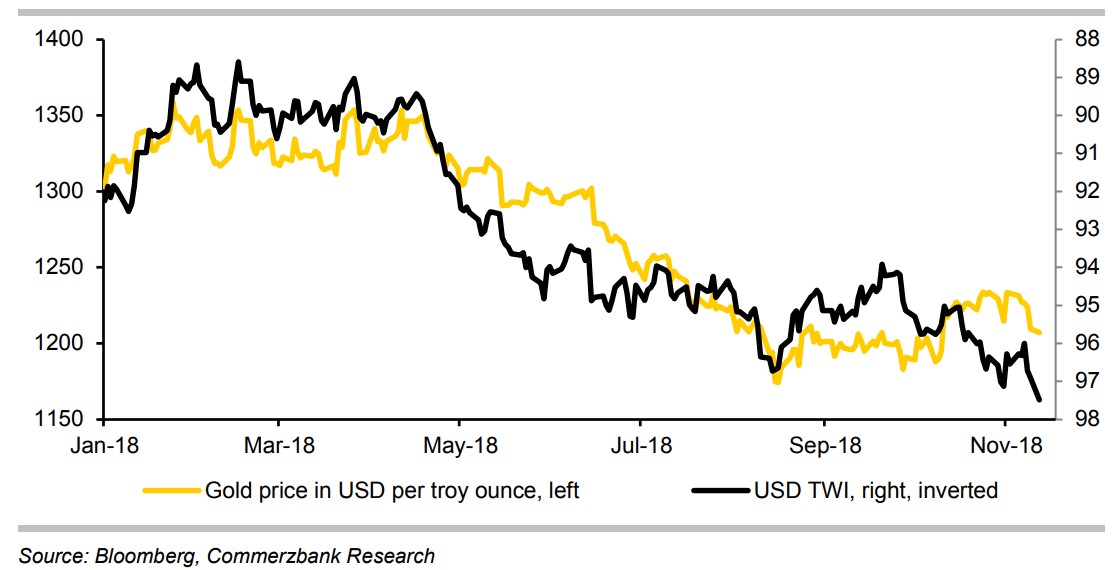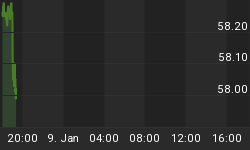Monday, November 12, 2018
Markets down to start the week. Global stocks saw a sea of red ink on Monday as the dollar strengthened to its highest point in nearly 18 months. Also, tech stocks were hit hard. Apple (NASDAQ: AAPL) reported record earnings but investors grew concerned about whether or not it could keep up robust sales. Meanwhile, Saudi Arabia moved to stop a slide in oil prices, promising to cut output.
Chart of the Week

(Click to enlarge)
- The U.S. dollar strengthened significantly this year, and after a brief hiatus in September, the greenback has gained further ground in the last two weeks. The dollar is at its strongest point in a year and a half.
- The ramifications of a stronger dollar are profound and widespread. On Monday, the dollar hit stocks, bonds and also a range of commodities.
- Emerging markets have also struggled under the weight of a strong dollar, which could impede economic growth as we head into 2019.
Markets
British pound slides on Brexit odds. The British pound fell by 1 percent on reports that Prime Minister Theresa May is under pressure to abandon her Brexit plan. The UK and the EU have made progress in negotiations but are also running short on time. In the UK, May is under pressure both from the opposition and from within her own party. “With Brexiteers and Remainers increasingly opposed to the plans being worked upon by May the chances of Parliamentary approval seem to be diminishing by the day, risking a political crisis,” Jeremy Stretch, head of Group-of-10 currency strategy at Canadian Imperial Bank of Commerce, told Bloomberg. “As a consequence, we can expect sterling to continue to take the strain.”
Stocks down, dollar up. The dollar jumped to its highest level in a year-and-a-half on Monday, strengthened by political instability in Europe at a time when the Fed continues to hike interest rates. The Wall Street Journal Dollar Index, which measures the greenback against a basket of 16 currencies, rose 0.3 percent to 90.87 in early trading on Monday. The gains came as the British pound hit the skids and fresh signs of a slowdown emerged in China.
Russia seeks to undermine dollar. Russia’s central bank has increased its gold reserves, sold U.S. treasuries and is now planning to conduct more of its trade in rubles and other currencies, according to the Wall Street Journal. As U.S. sanctions bite, Russia has tried to work around the U.S. Treasury. A growing number of analysts see the overuse of sanctions by the Trump administration as a threat to the dollar in the long run. Russian President Vladimir Putin echoed that sentiment last month when he said the use of sanctions was a “colossal strategic mistake” undermining confidence in the dollar as a universal currency. “They are sawing the branch on which they sit.”
Commodities
Gold falls to one-month low. Gold prices fell close to $1,200 per troy ounce in early trading on Monday, a one-month low. Prices fell below the 100-day moving average, and if prices dip below $1,200, there could be a stronger downside risk due to technical selling, according to Commerzbank. The uptick in the dollar has weighed on gold prices, and the standoff between Italian government and the European Union over Italy’s budget deficit has also plagued gold. Related: New Attorney General Tied To “American Dream” Scam
Aluminum prices low, but is market actually oversupplied? Aluminum prices have been zigzagging for several months, but have generally been following a downward trend. Dollar strength has played a part, as well as concerns over global economic growth, especially in the wake of the U.S.-China trade war. Prices are down 10 percent over the past month. However, there is disagreement over whether or not the market is actually oversupplied. Some analysts suggest low inventories mean the market is actually tighter than many believe. Metals consultancy CRU estimates that global aluminum inventories will hit 11 million tonnes at the end of the year. “That’s about 61 days of global consumption and the lowest since 2007 when stocks dropped to 50 days,” Eoin Dinsmore of CRU told Reuters. “Anything below 60 days is a tight market, we will drop below 50 days by 2020.”
Oil joins other commodities in swoon. The bear market for crude oil means that it no longer is the exception to the rule. A wide range of commodities have been under pricing pressure this year, due to trade concerns and a slowdown in global growth. Copper is down 18 percent this year and sugar is down 15 percent, for example. Oil defied this trend up until recently. The Wall Street Journal reports that commodity investors have now lost one of their lone bright spots. “They just got sideswiped. Now the question is: Do they stay in or get out of the trade?” Bart Melek, head of commodity strategy at TD Securities, told the WSJ. “We’re getting inquiries from all over the place.”
Energy
OPEC should cut by 1 mb/d. OPEC+ should cut its output by about 1 million barrels per day from October levels, Saudi oil minister Khalid al-Falih said on Monday. Al-Falih signaled that Saudi Arabia could cut output by around half that amount in December. The cartel has ramped up production and the market is starting to show some signs of oversupply. It is unclear if the OPEC+ coalition can agree on a production cut, but a reduction from Saudi Arabia would help put a floor beneath prices and stop the slide.
Oil enters bear market. WTI officially entered a bear market last week, with prices having fallen by more than 20 percent below their October peak. The intention of Saudi Arabia to cut production next month helped stop the downturn, firming up prices on Monday. The reduction is not necessarily decisive, however, and the market will likely await more clarity. “If it’s a cut of half a million, it’s not that much considering the increase from the U.S. and considering the global balances that we have for next year,” Petromatrix Managing Director Olivier Jakob told Bloomberg.
Related: Amazon’s Tale Of Two Cities
OPEC drills for long haul. Several OPEC members are stepping up drilling now in order to expand their production capacity for the long-term. Iraq, Kuwait, Saudi Arabia and the UAE are drilling wells to keep production up, while also investing in expansion. The UAE, for instance, announced a 22 percent increase in spending this month. “Globally we’re looking at a pretty flat picture, but underneath that headline number there is growth in some areas” of upstream investment, Richard Mallinson, an analyst with consultant Energy Aspects Ltd., told Bloomberg. “We’re beginning to see a pick up in activity from some of the state-owned producers in the Middle East.”
Cryptocurrencies
Binance CEO: Bitcoin bull run inevitable. The head of bitcoin exchange Binance, Changpeng Zhao, said that a bull run for Bitcoin was inevitable sooner or later. “Even if I don’t know what will catalyze a bitcoin bull run, I am certain it will happen... Sooner or later, something will trigger it,” he told CNBC’s Crypto Trader program. Bitcoin is down almost 90 percent since January, but he looked at the upside. “Compared to January [of 2018], we are probably down 90 percent. So we only have one-tenth of the trading volume compared to what we had in January. But, compared to like a year or two years ago, we’re still trading at huge volumes. Business is still okay, we are still profitable, and we are still a very healthy business,” Zhao said.
IBM patent aims for blockchain scientific research. IBM filed a patent application for a blockchain-based technology that would allow for “open scientific research” that would allow researchers to track their work across institutional borders. IBM’s patent aims to establish a system that provides “a tamper resistant log of scientific research.”
Colorado cracks down on ICOs. Colorado regulators took action against four ICOs on Thursday, including Bitcoin Investments, PinkDate, Prisma and Clear Shop Vision Ltd. “We want to ensure that the state's securities market and the investors that operate within it are protected from unscrupulous actors that are taking advantage of the enthusiasm surrounding this field to perpetrate fraud and in some cases outright theft,” Colorado Securities Commissioner Gerald Rome told CoinDesk. “There are many companies in Colorado that are working hard to conduct their ICOs the right way, and we are eager to continue working with them to build a regulatory framework for the industry as it relates to securities.” Colorado has issued cease-and-desist orders to a total of 12 crypto startups.
By Josh Owens for Safehaven.com
More Top Reads From Safehaven.com:
















